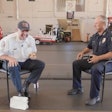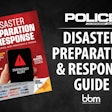 To end the killing from an active shooter attack as quickly as possible, a sole officer often must move to contact and end the threat.
To end the killing from an active shooter attack as quickly as possible, a sole officer often must move to contact and end the threat.
It has been 23 years since the 1999 Columbine High School massacre and still law enforcement performance against active shooters is spotty at best and unpredictable at the worst.
To identify what is lacking in law enforcement preparation to counter active shooters, we should examine the elements of successful attacks. The elements of a successful attack are: motivation, confidence in ability, objective drive, preparation, and flexibility. Defeating such robust threats, requires us to wrestle the initiative away from the killer through a highly motivated, mission-oriented, intent-driven, operationally literate, consistently proficient response. That means we have to adopt mission command philosophy and the development of an active shooter response doctrine.
Response Doctrine
Active shooter response is in the first two phases of the mission a military movement to contact that includes casualty collection and evacuation. That means we can borrow from the military to develop an active shooter response doctrine.
Military doctrine is defined on Wikipedia as “…the expression of how military forces contribute to campaigns, major operations, battles, and engagements. It is a guide to action, rather than being hard and fast rules. Doctrine provides a common frame of reference across the military. It helps standardize operations, facilitating readiness by establishing common ways of accomplishing military tasks. Doctrine links theory, history, experimentation, and practice. Its objective is to foster initiative and creative thinking. Doctrine provides the military with an authoritative body of statements on how military forces conduct operations and provides a common lexicon for use by military planners and leaders.”
Given this definition, we should now ask what is our national law enforcement strategy for defeating an active shooter. Are the current active shooter protocol and best practices good enough to codify a median performance of response nationally? Do they meet the needs of national law enforcement to defeat a wide spectrum of threats? I think historically speaking, the answer is no.
A law enforcement doctrine to address active shooter incidents must include both tactical doctrine and operational doctrine. Both are established for active threat and mass casualty incidents. The additional doctrine, mission command philosophy, basic core tactics, and training management must be indoctrinated into everyday law enforcement agency culture.
Tactical Doctrine
The U.S. Army defines tactics as “the employment and ordered arrangement of forces in relation to each other. They include the ordered arrangement and maneuver of units in relation to each other, the terrain, and the enemy in order to translate potential combat power into decisive results.”
Law enforcement tactical response to active shooter events is executed under the pressure of time, mixed jurisdictional forces, and incomplete information. A tactical doctrine includes principles in movement and maneuver, it also includes multiple techniques and procedures that account for mission, threat, terrain, law enforcement forces available, time, support available, and presence of civilians. Tactical principles establish such things as general placement of leadership, movement principles, and contact principles. Judgment plays a large role in execution of tactics, so tactical doctrine is more descriptive, rather than prescriptive. Tactical doctrine must be employable by a multi-agency force, applicable to all sizes of agencies, and incrementally applicable in single threat to multi-threat coordinated attacks. The tactical doctrine must consider law enforcement strengths, weaknesses, and their effect on span of control and size of elements.
Operational Doctrine
Active shooter response operations tend to involve multiple agencies in the region. A cohesive plan that is published and disseminated to all agencies in the region is needed. A progressive active command and control center functioning 24/7 is pertinent in detecting and coordinating assets, especially in the case of coordinated attack detection and response. Regional and/or county partners should organize available units in capacities that take advantage of asset capabilities. The regional command’s duty is to develop a joint concept of operations in active shooter events, with mission statements pushed down to the specific sub-units such as patrol, SWAT, K-9 officers, bomb technicians, investigators, and more.
Active shooter response operations should flow seamlessly throughout the entire mission and be designed to end hostilities at the first opportunity. It begins with the sole responder moving to contact to finish the threat. In cases where additional officers are needed, sole responders will coordinate efforts with other officers to find, fix, and finish the threat.
The operation concept also establishes warm zones for lifesaving medical treatment and evacuation. Other areas of operational organization are the staging of responding neighboring jurisdictional assets, containment, clearing operations, evacuation and reunification, and investigation.
The key to operational planning success is the establishment of a command authority with duties and responsibilities, subordination to that command by regional partners, joint planning with representatives from all agencies, and complete dissemination of the plan to every officer in the region.
Mission Command Philosophy
Mission command philosophy is the linchpin in the development of a highly motivated, problem-solving, and decision-making force of officers. The U.S. Army defines mission command philosophy as, “…exercise of authority and direction by the commander, using mission orders to enable disciplined initiative with commander’s intent to empower agile and adaptive leaders in the conduct of unified land operations.” Mission command philosophy is front and center in each component of a sound active shooter response doctrine.
The Army further outlines six principles or fundamentals of mission command. They include mutual trust, shared understanding, commander intent, disciplined initiative, mission orders, and prudent risk. Let’s dig into these concepts.
Mutual Trust is the foundational piece of mission command. Commanders must be able to trust subordinate leaders in their ability to lead in an environment where they have latitude to find innovative ways to support command’s vision.
Command also must trust that the subordinate leaders are developing the agency’s officers to be able to do the same and to assume greater roles in the absence of formal leaders. The subordinate leadership must trust that the command and training staff are going to provide the necessary equipment, support, and training to accomplish the mission and will morally support them. Officers must trust in their leaders and command to do the same.
Shared Understanding means that officers must be competent through mastery of basic common core tactical skills and embrace the mission command philosophy through knowing mission orders, understanding the commander’s intent, and by showing competence in operating in decentralized problem-solving and decision-making exercise evaluations. Subordinate leaders must do the same, but also understand their responsibility in the training and leading of their subordinates. The staff must be able to bring into practice the commander’s vision of intent, through the development of an operational plan and a training plan that will meet the needs of a mission command culture.
Commander Intent is “a clear and concise expression of the purpose of the operation and the desired end-state.” Intent provides focus to trainers and helps subordinate leaders and their officers to act and achieve the commander’s desired outcome. “A well crafted commander’s intent conveys a clear image of the purpose, key tasks, and the desired outcome/end-state,"the Army says.
Disciplined Initiative is defined by the Army as “action in the absence of orders, when existing orders no longer fit the situation, or when unforeseen opportunities or threat arise.” Subordinate leaders and officers exercise disciplined initiative to develop situations, and act when opportunities arise. Disciplined initiative is needed in order to achieve the commander’s vision and end-state. Commander’s intent provides the necessary freedom for officers and subordinate leaders to take the initiative and act within the confines of guidance, which in turn produces an agile force.
Mission Orders is how command directs subordinates to the task at hand. It is a brief who, what, where, when, and why. Subordinates then have the freedom to operate within the confines of intent and develop how they will achieve mission success.
Prudent Risk is “a deliberate exposure to potential injury or loss when leaders or officers judge the outcome in terms of mission accomplishment as worth the cost.” Commanders, subordinate leaders, and officers must accept prudent risk to achieve mission success in active shooter incidents. Armed confrontation requires deliberate exposure to possible injury or loss, in order to achieve desired outcomes. Prudent risk is often required to seize the initiative from the threat.
Training Doctrine
Nationally law enforcement suffers from a lack of competency in core tactical skills. That is not to say we lack tactically sound and highly skilled officers. Those officers exist because they make it their business to be highly skilled. Nationally, law enforcement lacks an acceptable minimum standard of tactical competency. A level of minimum competency across an agency officer corps must be achieved to fully realize the benefits of mission command philosophy.
Competency breeds confidence, and confidence breeds disciplined initiative and prudent risk taking. To achieve competency, law enforcement needs frequency in training. Frequent training is a duty and responsibility for small unit leaders. Small unit leaders are a law enforcement agency’s first tier of trainers, responsible for instructing their officers at individual, collective, and action drill tasks during times of opportunity. The agency’s second tier of trainers is agency officers selected for their skills, motivation, and ability to operate independently. The second tier trainers deliver agency training in force on force, live fire exercises (LFX), and teach all use-of-force training. This will calibrate all agencies in use of force at the regional level.
To achieve a consistent, proficient law enforcement response to active shooter response agencies must embrace mission command philosophy, and responsibility sharing for officers, small unit leaders, commands, and civilian government.
Scott Hyderkhan is president of Kinetic Tactical Training Solutions LLC, a company focused on tactical, training, and operational doctrine pertaining to active shooter response. He is the author of the book “Active Shooter Response Training: Lone Wolf to Coordinated Attacks.” Hyderkhan retired from the Mercer Island (WA) Police Department after 19 years of service where he was a patrol officer, Tactical Response Team member, and a regional active shooter response trainer. He is a retired Ranger-qualified U.S. Army master sergeant.















